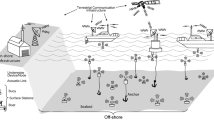Abstract
An efficient MAC protocol can reduce the collision and increase the throughput of the wireless sensor networks. Due to the long propagation delay and the low data rate, many transmissions of control packets will occupy a lot of channel resources, power and transmission time. In this paper, we propose a receiver-initiated MAC protocol with packet train for UWSN called multi-receiver MAC protocol (MR-MAC). Our protocol will increase of the throughput and reduce of the transmission of control packet for handshaking. Our MR-MAC protocol can make more than two nodes to communicate in one handshake held by a main receiver. By scheduling the packet transmission time, the data packet will be sent in a packet train manner and the receiver can receive data packet without collision. Our simulation results show that our protocol can increase the throughput and decrease the packet delay than the other existing MAC protocols.












Similar content being viewed by others
References
Akyildiz, I. F., Su, W., Sankarasubramaniam, Y., & Cayirci, E. (2002). Wireless sensor networks: A survey. Computer Networks, 38, 393–422.
Akyildiz, I. F., Pompili, D., & Melodia, T. (2005). Underwater acoustic sensor networks: Research challenges. Ad Hoc Network, 3, 257–279.
Akyildiz, I.F., Pompili, D., & Melodia, T. (2006). Routing algorithm for delay-insensitive and delay-sensitive applications in underwater sensor networks. In The annual international conference on mobile computing and networking, ACM.
Freitag, L., Grund, M., Singh, S., Partan, J., Koski, P., & Ball, K. (2005). The WHOI micro-modem: An acoustic communications and navigation system for multiple platforms. In: IEEE oceanic engineering society (OES) and marine technology society (MTS).
Heidemann, J., Ye, W., Wills, J., Syed, A., & Li, Y. (2006). Research challenges and applications for underwater sensor networking. In Wireless communications and networking conference
Djukic, P., & Valaee, S. (2009). Delay aware link scheduling for multi-hop TDMA wireless networks. IEEE ACM Transactions on Network, 17, 870–883.
Chirdchoo, N., Soh, W.-S., & Chua, K. C. (2008). RIPT: A receiver-initiated reservation-based protocol for underwater acoustic networks. IEEE Journal on Selected Areas in Communications, 26, 1744–1753.
Ye, W., Heidemann, J., & Estrin, D. (2002). An energy-efficient MAC protocol for wireless sensor networks. In: IEEE international conference on computer communications.
Bharghavan, V., Demers, A., Shenker, S., & Zhang, L. (1994). MACAW: A media access protocol for wireless LAN’s. In: Special interest group on data communications conference, ACM.
Ye, W., Heidemann, J., & Estrin, D. (2004). Medium access control with coordinated adaptive sleeping for wireless sensor networks. IEEE/ACM Transactions on Networking, 12(3), 493–506.
Dam, T.-V., & Langendoen, K. (2003). An adaptive energy-efficient MAC protocol for wireless sensor networks. In: International conference on embedded networked sensor systems, ACM.
Moon, Y., & Syrotiuk, V. R. (2010). A cooperative dual access multi-channel MAC protocol for Ad Hoc networks. In: Global telecommunications conference, IEEE.
Yang, G., Shen, C.-C., & Yackoski, J. (2011). MAC scheduling for high throughput underwater acoustic networks. In: Wireless communications and networking conference, IEEE.
Molins, M., & Stojanovic, M. (2006). Slotted FAMA: A MAC protocol for underwater acoustic networks. In: IEEE oceanic engineering society (OES) and marine technology society (MTS).
Kebkal, O., Komar, M., Kebkal, K., & Bannasch, R. (2011). D-MAC: Media access control architecture for underwater acoustic sensor networks. In: IEEE oceanic engineering society (OES) and marine technology society (MTS).
Guo, X., Frater, M. R., & Ryan, M. J. (2006). A propagation-delay-tolerant collision avoidance protocol for underwater acoustic sensor networks. In IEEE oceanic engineering society (OES) and marine technology society (MTS).
Chen, Y.-D., Liu, S.-S., Chang, C.-M., & Shih, K.-P. (2011). CS-MAC: A channel stealing MAC protocol for improving bandwidth utilization in underwater wireless acoustic networks. In IEEE oceanic engineering society (OES) and marine technology society (MTS).
Ng, H.-H., Soh, W.-S., & Motani, M. (2010). BiC-MAC: Bidirectional-concurrent MAC protocol with packet bursting for underwater acoustic networks. In IEEE oceanic engineering society (OES) and marine technology society (MTS).
Chirdchoo, N., Soh, W.-S., & Chua, K. C. (2008). MACA-MN: A MACA-based MAC protocol for underwater acoustic networks with packet train for multiple neighbors. In Vehicular technology conference.
Ng, H.-H., Soh, W.-S., & Motani, M. (2010). ROPA: A MAC protocol for underwater acoustic networks with reverse opportunistic packet appending. In Wireless communications and networking conference, IEEE.
Syed, A., Ye, W., Krishnamachari, B., & Heidemann J. (2007). Understanding spatio-temporal uncertainty in medium access with ALOHA protocol. In International conference on underwater networks and systems, ACM.
Acknowledgments
This work was supported in part by the National Science Council, Taiwan, under Grant NSC102-2221-E-036-012, and Tatung University, under Grant B103-N05-037.
Author information
Authors and Affiliations
Corresponding author
Rights and permissions
About this article
Cite this article
Liao, WH., Kuai, SC. & Lin, YC. A Receiver-Initiated MAC Protocol with Packet Train Design for Underwater Acoustic Sensor Networks. Wireless Pers Commun 82, 2155–2170 (2015). https://doi.org/10.1007/s11277-015-2339-9
Published:
Issue Date:
DOI: https://doi.org/10.1007/s11277-015-2339-9




